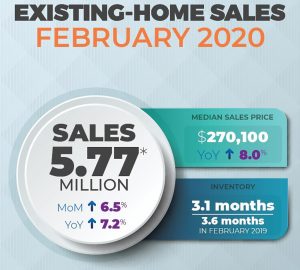Existing-home sales climbed substantially in February after a slight decline in January, according to the National Association of Realtors®. Of the four major regions, only the Northeast reported a drop in sales, while other areas saw increases, including sizable sales gains in the West.
Total existing-home sales,1 completed transactions that include single-family homes, townhomes, condominiums and co-ops, rose 6.5% from January to a seasonally-adjusted annual rate of 5.77 million in February. Additionally, for the eighth straight month, overall sales greatly increased year-over-year, up 7.2% from a year ago (5.38 million in February 2019).

NAR Chief Economist, Lawrence Yun
“February’s sales of over 5 million homes were the strongest since February 2007,” said Lawrence Yun, NAR’s chief economist. “I would attribute that to the incredibly low mortgage rates and the steady release of a sizable pent-up housing demand that was built over recent years.”
The median existing-home price2 for all housing types in February was $270,100, up 8.0% from February 2019 ($250,100), as prices rose in every region. February’s price increase marks 96 straight months of year-over-year gains.
Yun noted that February’s home sales were encouraging but not reflective of the current turmoil in the stock market or the significant hit the economy is expected to take because of the coronavirus and corresponding social quarantines. “These figures show that housing was on a positive trajectory, but the coronavirus has undoubtedly slowed buyer traffic and it is difficult to predict what short-term effects the pandemic will have on future sales,” Yun said.
Total housing inventory3 at the end of February totaled 1.47 million units, up 5.0% from January, but down 9.8% from one year ago (1.63 million). Unsold inventory sits at a 3.1-month supply at the current sales pace, equal to the supply recorded in January and down from the 3.6-month figure recorded in February 2019.
Properties typically remained on the market for 36 days in February, seasonally down from 43 days in January, and down from 44 days in February 2019. Forty-seven percent of homes sold in February 2020were on the market for less than a month.

First-time buyers were responsible for 32% of sales in February, equal to the percentages seen in both January 2020 and in February 2019. NAR’s 2019 Profile of Home Buyers and Sellers – released in late 20194 – revealed that the annual share of first-time buyers was 33%.
“For the past couple of months, we have seen the number of buyers grow as more people enter the market,” Yun said. “Once the social-distancing and quarantine measures are relaxed, we should see this temporary pause evaporate, and will have potential buyers return with the same enthusiasm.”
While offering a definitive forecast is extremely difficult in light of this national and global emergency, Yun says home prices will hold on well. “Unlike the stock market, home prices are not expected to drop because of the on-going housing shortage and due to homes getting delisted during this time of crisis,” he said.
Individual investors or second-home buyers, who account for many cash sales, purchased 17% of homes in February, equal to January and up slightly from 16% in February 2019. All-cash sales accounted for 20% of transactions in February, down from both 21% in January and from 23% in February 2019.
Distressed sales5 – foreclosures and short sales – represented 2% of sales in February, unchanged from January and down from February 2019.
Realtor.com®‘s Market Hotness Index, measuring time-on-the-market data and listing views per property, revealed that the hottest metro areas in February were Colorado Springs, Colo.; Lafayette–West Lafayette, Ind.; Modesto, Calif.; Rochester, N.Y.; and Sacramento–Roseville-Arden-Arcade, Calif.
According to Freddie Mac, the average commitment rate for a 30-year, conventional, fixed-rate mortgage decreased to 3.47% in February, down from 3.62% in January. The average commitment rate across all of 2019 was 3.94%.
“In the midst of this national emergency, NAR has been and will continue to be in contact with Congressional leaders and White House officials as they consider various policies to ease the economic impact of the coronavirus,” said NAR President Vince Malta, broker at Malta & Co., Inc., in San Francisco, Calif. “NAR is engaged in these discussions and presenting proposals that will support real estate and the people that make up the industry.”
“It is truly inspiring to see so many of our fellow Realtors® and brokerages adjust on the fly,” Malta continued. “Agents nationwide are keeping interest alive with innovative technologies, holding virtual open houses and computer-generated tours.”
Single-family and Condo/Co-op Sales
Single-family home sales sat at a seasonally-adjusted annual rate of 5.17 million in February, up from 4.82 million in January, and up 7.3% from a year ago. The median existing single-family home price was $272,400 in February, up 8.1% from February 2019.
Existing condominium and co-op sales were recorded at a seasonally adjusted annual rate of 600,000 units in February, about even with January’s sales, but 7.1% higher than a year ago. The median existing condo price was $249,900 in February, an increase of 7.0% from a year ago.
Regional Breakdown
Compared to the month prior, February sales increased in the Midwest, the South and the West, while year-over-year sales are up in each of the four regions. Median home prices in all regions increased from one year ago, with the Northeast and South regions showing the strongest price gains.
February 2020 existing-home sales in the Northeast fell 4.1%, recording an annual rate of 700,000, a 2.9% increase from a year ago. The median price in the Northeast was $295,400, up 8.2% from February 2019.
Existing-home sales increased 0.8% in the Midwest to an annual rate of 1.29 million, up 4.0% from a year ago. The median price in the Midwest was $203,700, a 7.9% increase from February 2019.
Existing-home sales in the South climbed 7.2% to an annual rate of 2.52 million in February, up 8.2% from the same time one year ago. The median price in the South was $238,000, an 8.2% increase from a year ago.
Existing-home sales in the West surged 18.9% to an annual rate of 1.26 million in February, an 11.5% increase from a year ago. The median price in the West was $410,100, up 8.1% from February 2019.
The National Association of Realtors® is America’s largest trade association, representing more than 1.4 million members involved in all aspects of the residential and commercial real estate industries.
For local information, please contact the local association of Realtors® for data from local multiple listing services (MLS). Local MLS data is the most accurate source of sales and price information in specific areas, although there may be differences in reporting methodology.
NOTE: NAR’s Pending Home Sales Index for February is scheduled for release on March 30, and Existing-Home Sales for March will be released April 21; release times are 10:00 a.m. ET.
1 Existing-home sales, which include single-family, townhomes, condominiums and co-ops, are based on transaction closings from Multiple Listing Services. Changes in sales trends outside of MLSs are not captured in the monthly series. NAR rebenchmarks home sales periodically using other sources to assess overall home sales trends, including sales not reported by MLSs.
Existing-home sales, based on closings, differ from the U.S. Census Bureau’s series on new single-family home sales, which are based on contracts or the acceptance of a deposit. Because of these differences, it is not uncommon for each series to move in different directions in the same month. In addition, existing-home sales, which account for more than 90% of total home sales, are based on a much larger data sample – about 40% of multiple listing service data each month – and typically are not subject to large prior-month revisions.
The annual rate for a particular month represents what the total number of actual sales for a year would be if the relative pace for that month were maintained for 12 consecutive months. Seasonally adjusted annual rates are used in reporting monthly data to factor out seasonal variations in resale activity. For example, home sales volume is normally higher in the summer than in the winter, primarily because of differences in the weather and family buying patterns. However, seasonal factors cannot compensate for abnormal weather patterns.
Single-family data collection began monthly in 1968, while condo data collection began quarterly in 1981; the series were combined in 1999 when monthly collection of condo data began. Prior to this period, single-family homes accounted for more than nine out of 10 purchases. Historic comparisons for total home sales prior to 1999 are based on monthly single-family sales, combined with the corresponding quarterly sales rate for condos.
2 The median price is where half sold for more and half sold for less; medians are more typical of market conditions than average prices, which are skewed higher by a relatively small share of upper-end transactions. The only valid comparisons for median prices are with the same period a year earlier due to seasonality in buying patterns. Month-to-month comparisons do not compensate for seasonal changes, especially for the timing of family buying patterns. Changes in the composition of sales can distort median price data. Year-ago median and mean prices sometimes are revised in an automated process if additional data is received.
The national median condo/co-op price often is higher than the median single-family home price because condos are concentrated in higher-cost housing markets. However, in a given area, single-family homes typically sell for more than condos as seen in NAR’s quarterly metro area price reports.
3 Total inventory and month’s supply data are available back through 1999, while single-family inventory and month’s supply are available back to 1982 (prior to 1999, single-family sales accounted for more than 90% of transactions and condos were measured only on a quarterly basis).
4 Survey results represent owner-occupants and differ from separately reported monthly findings from NAR’s Realtors®Confidence Index, which include all types of buyers. Investors are under-represented in the annual study because survey questionnaires are mailed to the addresses of the property purchased and generally are not returned by absentee owners. Results include both new and existing homes.
5 Distressed sales (foreclosures and short sales), days on market, first-time buyers, all-cash transactions and investors are from a monthly survey for the NAR’s Realtors® Confidence Index, posted at nar.realtor.





